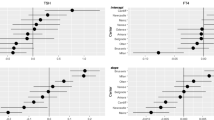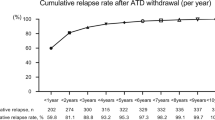Abstract
Objective
To assess the predictive value of some clinical and biochemical parameters, and of the +49 A/G polymorphism of the CTLA-4 gene, for long-term remission following the withdrawal of antithyroid drugs before starting antithyroid drug therapy.
Study design
Observational, prospective and longitudinal study.
Methods
Seventy-two patients (11 of whom were men) with newly diagnosed Graves’ hyperthyroidism who had been attended consecutively at a University Clinic in a population with sufficient iodine intake were included in the study. Exclusion criteria: patients under the age of 18, pregnant women and non-Caucasian patients. All subjects were treated following a well-defined protocol. Long-term remission was calculated at 12 and 36 months following withdrawal of the antithyroid drug.
Results
Thirty-six of the 72 study subjects experienced a remission of at least 12 months following withdrawal of methimazole, with no differences according to their age or sex. A comparison made between the remission rates seen in both groups yielded significant differences regarding the presence of Graves’ orbitopathy, the duration of the treatment with methimazole and the absence of the CTLA-4 G/G genotype. In the univariate and multivariate analyses performed, only lower frequencies of Graves’ orbitopathy and an absence of the CTLA-4 G/G genotype were considered independent predictors of long-term remission.
Conclusions
The absence of Graves’ orbitopathy and of the CTLA-4 G/G genotype are independent predictors of long-term remission following a first course of antithyroid drugs.
Similar content being viewed by others
References
B.S. Prabhakar, R.S. Bahn, T.J. Smith, Current perspectives on the pathogenesis of Graves’ disease and ophthalmopathy. Endocr. Rev. 24, 802–835 (2003)
I. Klein, K. Ojamaa, Thyroid hormones and the cardiovascular system. N. Engl. J. Med. 344, 501–509 (2001)
R.S. Bahn, H.B. Burch, D.S. Cooper, J.R. Garber, M.C. Greenlee, I. Klein, P. Laurberg, I.R. McDougall, V.M. Montori, S.A. Rivkees, D.S. Ross, J.A. Sosa, M.N. Stan, Hyperthyroidism an other causes of thyrotoxicosis: management guidelines of the American Thyroid Association and American Association of Clinical Endocrinologists. Endocr. Pract. 17, 456–520 (2011)
J.L. Codaccioni, J. Orgiazi, M. Pugeat, R. Roulier, P. Carayon, Lasting remission in patients treated for Graves’ hyperthyroidism with propranolol alone: a pattern of spontaneous evolution of the disease. J. Clin. Endocrinol. Metabol. 67, 656–662 (1988)
G.F. Fenzi, K. Hashizume, C.P. Roudeboush, L.J. DeGroot, Changes in thyroid-stimulating immunoglobulins during antithyroid therapy. J. Clin. Endocrinol. Metabol. 48, 572–576 (1979)
R. Docter, G. Bos, T.J. Visser, G. Hennemann, Thyrotrophin binding inhibiting immunoglobulins in Graves’ disease before, during and after antithyroid therapy and its relation to long-acting thyroid stimulator. Clin. Endocrinol. 12, 143–153 (1980)
A.M. MacGregor, M.M. Petersen, S.M. McLachlan, P. Rooke, B.R. Smith, R.R. Hall, Carbimazole and the autoimmune response in Graves’ disease. N. Engl. J. Med. 303, 302–307 (1980)
K.W. Wenzel, J.R. Lente, Similar effects of thionamide drug and perchlorate on thyroid-stimulating immunoglobulins in Graves’ disease: evidence against an immunosuppressive action of thionamide drugs. J. Clin. Endocrinol. Metabol. 58, 62–69 (1984)
O. Torring, L. Tallstedt, G. Wallin, G. Lundell, J.G. Ljunggren, A. Taube, M. Saaf, B. Hamberger, Graves’ hyperthyroidism: treatment with antithyroid drugs, surgery or radio iodine- a prospective randomized study. J. Clin. Endocrinol. Metabol. 81, 2986–2993 (1996)
L. Wartofsky, D. Glinoer, B. Solomon, S. Nagataki, R. Lagasse, Y. Nagayama, M. Izumi, Differences and similarities in the diagnosis and treatment of Graves’ disease in Europe, Japan and the United States. Thyroid 11, 129–135 (1991)
J.H. Moon, K.H. Yi, The diagnosis and management of hyperthyroidism in Korea: consensus report of the Korean thyroid association. Endocrinol. Metabol. 28, 275–279 (2013)
D.S. Ross, H.B. Burch, D.S. Cooper, M.C. Greenlee, P. Lauberg, A.L. Maia, S.A. Rivkees, M. Samuels, A. Sosa, M.N. Stan, M.A. Walter, American Thyroid Association guidelines for diagnosis and management of hyperthyroidism and other causes of thyrotoxicosis. Thyroid 26, 1343–1421 (2016)
R.V. García-Mayor, Limitations of current thyroid function tests. Endocrinol. Diabet. Nutr. 64, 404–405 (2017)
A.J. Hedley, R.E. Young, S.J. Jones, P.D. Alexander, P.D. Bewsher, Antithyroid drugs in the treatment of hyperthyroidism of Graves’ disease: long-term follow up of 434 patients. Scottish automated follow-up register group. Clin. Endocrinol. 31, 209–218 (1989)
P. Abraham, A. Avenell, C.M. Park, W.A. Watson, J.S. Bevan, Systematic review of drug therapy of Graves’ hyperthyroidism. Eur. J. Endocrinol. 153, 489–498 (2005)
T. Struja, H. Fehlberg, A. Kutz, L. Guebelin, C. Degen, B. Mueller, P. Schuetz, Can we predict relapse in Graves’ disease? Results from a systematic review and meta-analysis. Eur. J. Endocrinol. 176, 87–97 (2017)
F. Magri, F. Zerbini, M. Gaiti, V. Capelli, A. Ragni, M. Rotondi, L. Chiovato, Gender influence the clinical presentation and long-term outcome of Graves disease. Endocr. Pract. 22, 1336–1342 (2016)
C.A. Chambers, M.F. Krummel, B. Boitel, A. Hurwitz, T.J. Sullivan, S. Fournier, D. Cassell, M. Brunner, J.P. Allison, The role of CTLA-4 in the regulation of T-cell responses. Immunol. Rev. 153, 27–34 (1996)
M. Maürer, S. Loserth, A. Kolb-Maurer, A. Ponath, S. Wiese, N. Kruse, P. Rieckmann, A polymorphism in human cytotoxic T lymphocyte antigen 4 (CTLA-4) gene (exon 1_49) alters T cell activation. Immunogenetics 54, 1–8 (2002)
P.W. Wang, R.T. Liu, S.H.H. Juo, S.T. Wang, Y.H. Hu, C.J. Hsieh, M.H. Chen, I.Y. Chen, C.I. Wu, Cytotoxic T lymphocyte-associated molecule-4 polymorphism and relapse of Graves’ hyperthyroidism after antithyroid withdrawal. J. Clin. Endocrinol. Metab. 89, 169–173 (2004)
R.V. García-Mayor, M. Ríos, E. Fluiters, L.F. Pérez Méndez, E. González, A. Andrade, Effect of iodine supplementation on a pediatric population with mild iodine deficiency. Thyroid 9, 1089–1093 (1999)
S. Peterson, A. Sanga, H. Eklöf, B. Bunga, A. Taube, M. Gebre-Medhin, H. Rosling, Classification of thyroid size by palpation and ultrasonografy in field surveys. Lancet 355, 106–110 (2000)
A.C. Werner, Modification of the classification of the eye changes of Graves’ disease: recommendations of the Ad Hoc Committee of American Thyroid Association. J. Clin. Endocrinol. Metabol. 44, 203–204 (1977)
J.T. Dunn, H.E. Crustchfield, R. Gutefunst, A.D. Dunn, Two simple methods for measuring iodine in urine. Thyroid 3, 119–123 (1993)
P. Álvarez-Vázquez, L. Constenla, R.V. García-Mayor, A. Larrañaga, D. Valverde, Association of CTLA4 gene polymorphism with ophthalmopathy of Graves’ disease in a Spanish population. Int. J. Endocrinol. Metabol. 9, 397–402 (2011)
R.V. Garcia-Mayor, P. Cobas, Resultados del tratamiento de la enfermedad de Basedow-Graves con antitiroideos: Estudio prospectivo. Endocrinologia 29, 56–60 (1982)
R.V. Garcia-Mayor, C. Paramo, R. Luna Cano, L.F. Pérez Méndez, J.C. Galofré, A. Andrade, Antithyroid drug and Graves? Hyperthyroidism. Significance of treatment duration and TRAb determination on lasting remission. J. Endocrinol. Invest. 15, 815–820 (1992)
L. Bartalena, E. Masiello, F. Magri, G. Veronesi, E. Bianconi, F. Zerbini, M. Gaiti, E. Sprafico, D. Gallo, P. Premoli, E. Piantanida, M.L. Tanda, M. Ferrario, P. Vitti, L. Chiovato, The phenotype of newly diagnosed Graves' disease in Italy in recent years is milder than in the past: results of a large observational longitudinal study. J. Endocrinol. Invest. 39, 1445–1451 (2016)
U. Feldt-Rasmussen, H. Schleusener, P. Carayon, Metaanalysis evaluation of the impact of thyrotropin receptor antibodies on long term remission after medical therapy of Graves’ disease. J. Clin. Endocrinol. Metabol. 78, 98–102 (1994)
T.J. Smith, L. Hegedus, Graves’ disease. N. Engl. J. Med. 375, 1552–1565 (2016)
J.A. Franklyn, K. Boelaert, Thyrotoxicosis. Lancet 379, 1155–1166 (2012)
J.M. Hershman, J.R. Givens, C.E. Cassidy, E.B. Astwood, Long-term outcome of hyperthyroidism treated with antithyroid drug. J. Clin. Endocrinol. Metabol. 26, 803–807 (1966)
D. Glinoer, D. Hesch, R. Lagasse, P. Lauberg, The management of hyperthyroidism due to Graves’ disease in Europe in 1987. Acta Endocrinol. 115(Suppl. 185), 3–23 (1986)
X.G. Vos, E. Endert, A.H. Zwindermena, J.G.P. Tijssen, W.M. Wiersinga, Predicting the risk of recurrence before the start of antithyroid drug therapy in patients with Graves’ hyperthyroidism. J. Clin. Endocrinol. Metabol. 101, 1381–1389 (2016)
P. Vitti, T. Rago, L. Chiovato, S. Pallini, F. Santini, E. Fiore, R. Rocchi, E. Martino, A. Pinchera, Clinical features of patients with Graves’ disease undergoing remission after antithyroid drug treatment. Thyroid 7, 369–375 (1997)
L.E. Kimball, E. Kulinskaya, B. Brown, C. Johnson, N.R. Farid, Does smoking increase relapse rates in Graves’ disease? J. Endocrinol. Invest. 25, 152–157 (2002)
E.T. Young, N.R. Steel, J.J. Taylor, A.M. Stephenson, A. Stratton, M. Holcombe, P. Kendall-Taylor, Prediction of remission after antithyroid drug treatment in Graves’ disease. Q. J. Med. 66, 175–189 (1988)
G. Benker, D. Reinwein, G. Kahaly, L. Tegler, W.D. Alexander, J. Fassbinder, H. Hirch, Is there a methimazole dose effect on remission rate in Graves’ disease? Results from a long-term prospective study. The European Multicentre Trial Group of the Treatment of hyperthyroidism with antithyroid drugs. Clin. Endocrinol. 49, 451–458 (1998)
P.W. Wang, I.Y. Chen, S.H. Hank Juo, E. Hsi, R.T. Liu, C.J. Hsieh, Genotype and phenotype predictors of relapse of Graves’ disease after antithyroid drug withdrawal. Eur. Thyroid J. 1, 251–258 (2012)
N.N.Z. Tun, G. Beckett, N.N. Zammnitt, M.W.J. Strachan, J.R. Seckl, G.W. Gibb, Thyrotropin receptor antibody levels at diagnosis and after thionamide course predict Graves’ disease relapse. Thyroid 26, 1004–1009 (2016)
G. Edan, C. Massart, N.Y. Poirier, M. Lé Reun, J.P. Hespel, G. Leclech, M. Simon, Optimun duration of antithyroid drug treatment determined by assay of thyroid stimulating antibody in patients with Graves’ disease. BMJ 298, 359–361 (1989)
Y. Takaichi, H. Tamai, K. Honda, K. Nagai, K. Kuma, T. Nakagawa, The significance of antithyroglobulin and antithyroidal microsomal antibodies in patients with hyperthyroidism due to Graves’ disease treated with antithyroid drugs. J. Clin. Endocrinol. Metabol. 68, 1097–1100 (1989)
A.K. Eckstein, H. Lax, C. Lösch, D. Glowacka, M. Plicht, K. Mann, J. Esser, N.G. Morgenthaler, Patients with severe Graves’ ophthalmopathy have a higher risk of relalsing hyperthyroidism and are unlikely to remain in remission. Clin. Endocrinol. 67, 607–612 (2007)
P.W. Wang, R.T. Liu, S.H.H. Juo, S.E. Wang, Y.H. Hu, C.J. Hsieli, M.H. Chen, I.Y. Chen, C.L. Wu, Cytotoxic T lymphocyte-associated molecule-4 polymorphism and relapse of Graves’ hyperthyroidism after antithyroid withdrawal: a follow-up study. J. Clin. Endocrinol. Metab. 91, 2513–2518 (2007)
S. Tanrikulu, Y. Erbil, E. Ademoglu, H. Issever, U. Barbaros, F. Kutkuturk, S. Ozarmagan, S. Tezelman, The predictive value of CTLA4 and Tg polimorphisms in the recurrence of Graves’ disease after antithyroid withdrawal. Endocrine 30, 377–381 (2006)
K.W. Kim, Y.J. Park, T.Y. Kim, D.J. Park, B.Y. Cho, K. Badenhoop, H. Donner, J. Braun, T. Siegmund, H. Raud, K.H. Usadel, Genetic markers in diagnosis and prediction of relapse in Graves’ disease. Exp. Clin. Endocrinol. Diabetes 104(Suppl. 4), 98–100 (1996)
E. Masiello, G. Vernonesi, D. Gallo, P. Premoli, E. Bianconi, S. Rosetti, C. Cusini, J. Sabatino, S. Ippolito, E. Piantanida, M.L. Tanda, L. Chiovato, W.M. Wiersinga, L. Bartalena. Antithyroid drug treatment for Graves’ disease: baseline predictive models of relapse after treatment for a patient-tailored management. J. Endocrinol. Invest. (2018). https://doi.org/10.1007/s40618-018-0918-9
Acknowledgements
The authors would like to thank Professor Juan Carlos Galofre for his critical reading of this manuscript.
Funding
This study was supported, in part, by a grant awarded by the Spanish Diabetes Society.
Author information
Authors and Affiliations
Corresponding author
Ethics declarations
Conflict of interest
The authors declare that they have no conflict of interest.
Ethical approval
This study was approved by the Research Ethics Committee of the Autonomous Government of Galicia.
Informed consent
All participants gave their consent after being verbally informed about the nature and purpose of this study.
Rights and permissions
About this article
Cite this article
García-Mayor, R.V., Álvarez-Vázquez, P., Fluiters, E. et al. Long-term remission following antithyroid drug withdrawal in patients with Graves’ hyperthyroidism: parameters with prognostic value. Endocrine 63, 316–322 (2019). https://doi.org/10.1007/s12020-018-1785-z
Received:
Accepted:
Published:
Issue Date:
DOI: https://doi.org/10.1007/s12020-018-1785-z




